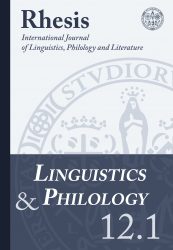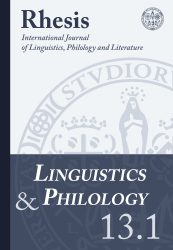 Linguistics and Philology
Linguistics and PhilologyVol. 12.1 - December 31, 2021
Download issue
Table of contents
| p. 5 | Multi-word insertions in code-mixed utterances: Italian-German code mixing in South TyrolSimone CiccoloneAbstract The present study proposes a corpus-based analysis of the distribution of insertional code mixing (cf. Muysken 2000) occurring in a corpus of bilingual speech collected in South Tyrol. The analysis uses two surface parameters (directionality and extension), not restrained to a specific theoretical model, to classify the switches. The aim of this study is to observe recurring patterns and functions in the combined use of codes within the utterance, in particular by comparing the functions and distribution of single-word switches with those of multi-word insertions (e.g. phrases, word combinations and idioms). The discussion shows the emergence of two macro-functional patterns consistently attested in both types of switches.
|
| p. 17 | Islands Isles Isole: A Sketch Engine Based Corpus AnalysisSimonetta FalchiAbstract According to Van Dijk (2018) it is feasible to delineate the mental model of the underlying notion held by an epistemic community by looking at the occurrences of a lexical item in a representative corpus. In this socio-cognitive study, the Sketch Engine platform’s tools are used to describe the collocational patterns of the English lemmas ISLAND/ISLE and their Italian equivalent ISOLA in two large corpora, following the model offered by Arroyo Hernández (2020). The investigation of semantic preferences and perceived semantic prosody shows an insular narrative, which is widely shared in both languages, in which the island is portrayed as a desired area defined by beauty and suggestion while also being vulnerable.
|
| p. 35 | Skandinaviens Ureinwohner und die Delikatessen der WikingerLorenzo Lozzi GalloAbstract With the expansion of the Germanic tribes from the Southernmost part of Scandinavia, it seems that the natives gradually retreated to the less hospitable areas in the North and on the mountains, less attractive for the newcomers due to a rigid climate and scarcity of arable land. Being predominantly hunters-gatherers, natives could hardly grow cereals in their areas of residence and therefore they may have relied entirely on trade with Vikings to acquire beer or bread. Some kinds of meat (pork, beef, mutton) were equally exotic to these tribes who had specialized in hunting and herding reindeer. About dairy products, reindeer milk is far less suited to be processed than cow milk, there is only one kind of traditional cheese. The diet of the natives must have been quite monotone (but for the short arctic summer) and Viking gastronomy must have been a more than welcome change in their usual nourishment – when they managed to get some. Even though the natives were often in contact with Vikings, they were also ready to steal food, when trade was not an option. Unlike Vikings, who could simply extort what they wanted from natives by force, the latter would rather recur to cunning and their superior ability to move through the hostile landscape (hence the Norse belief, these peoples must possess magical powers) for a taste of Viking delicacies. Gradually, their contacts would go much farther than gastronomy alone: the integration of natives into the modern nations proceeded throughout the modern era.
|
| p. 47 | Il plurilinguismo a scuola: un’indagine sulle pratiche didattichePaolo NittiAbstract This article deals with some research on the educational practices in language teaching within some multicultural educational contexts in the province of Varese, Italy. The data presented primarily relate to the educational practices of perception, taking into consideration both the strategies and the activities that teachers can perform with their students. Teaching practices exploration is an essential starting point for understanding how a multilingual education can be promoted, which is a vital goal for our schools and society. This aspect of language teaching represents a particular challenge for policy-makers and practitioners, since it requires new insights and a holistic language educational perspective.
|
| p. 66 | Comunità di pratica, comunità di discorso e comunità testuali tra sincronia e diacronia: alcune considerazioni preliminariIgnazio PutzuAbstract This article outlines briefly the concepts of community of practice, community of discourse and textual community from the perspective of current or possible use in historical sociolinguistics. A brief review of the literature highlights how the tendency to realign communities of practice, on the one hand, and discourse and textual communities, on the other, emerges quite widely in a relationship of inclusive specification: from this point of view, textual communities in particular tend to be understood as communities of practice centred around a text or a textual corpus to which reference is made.
|
| p. 89 | Parole, proverbi e modi di dire italiani, francesi e in francoprovenzale di Puglia intorno al cibo: spunti per un approccio intercomprensivo Maria Immacolata Spagna Abstract Our contribution intends to present two corpora, one of words and the other of proverbs and idioms, on the lexicon of food shared by three romance languages in order to educate plurilingualism: Francoprovençal of Puglia, a language with an oral tradition and endangered, but still spoken in Faeto and Celle di San Vito, two small villages in the Monti Dauni area of the province of Foggia, Italian, the mother tongue of many of the inhabitants, and French, a language toward which Faetani and Cellesi have a very positive attitude. To prevent this Apulian community’s Galloromance soul from dissolving into that Italoromance, the proposed corpora can serve as a starting point for intercomprehension, which, by highlighting individuals’ plurilingual and pluricultural competences, makes it possible to concretely achieve a plurilingual and pluricultural European context. Our study aims to give the Faetani and Cellesi a further push towards plurilingualism, based on the fact that belonging to an ethnolinguistic minority now constitutes a form of positive discrimination and thus an additional value, linked to the advantage of speaking multiple languages and experiencing multiple cultures.
|
Tags: Alto Adige, bilingual speech, cibo, code mixing, collocation, collocazioni, community of practice, comunità di discorso, comunità di pratica, comunità testuale, corpus linguistics, didattica della lingua italiana, discourse community, educational linguistics, enunciazione mistilingue, food, francese, Francoprovençal of Puglia, francoprovenzale di Puglia, French, glottodidattica, historical sociolinguistics, Ignazio Putzu, intercomprehension, intercomprensione, island, isle, isola, Italian language teaching, Italian Linguistics, language teaching, lessico del cibo, lexicon of food, linguistica dei corpora, linguistica educativa, linguistica italiana, Lorenzo Lozzi Gallo, Maria Immacolata Spagna, multilingualism, Paolo Nitti, parlato bilingue, plurilingualism, plurilinguismo, preferenza semantica, Sámi, Scandinavi, Scandinavia, semantic preference, Simone Ciccolone, Simonetta Falchi, sketch engine, sociolinguistica storica, South Tyrol, textual community, vichinghi, Vikings
 Linguistics and PhilologyVol. 12.1 - December 31, 2021
Linguistics and PhilologyVol. 12.1 - December 31, 2021
